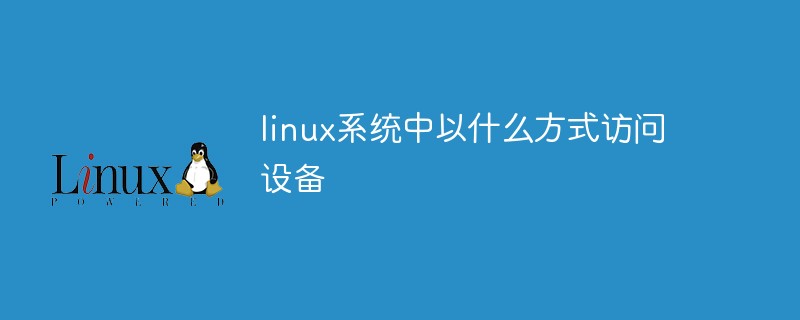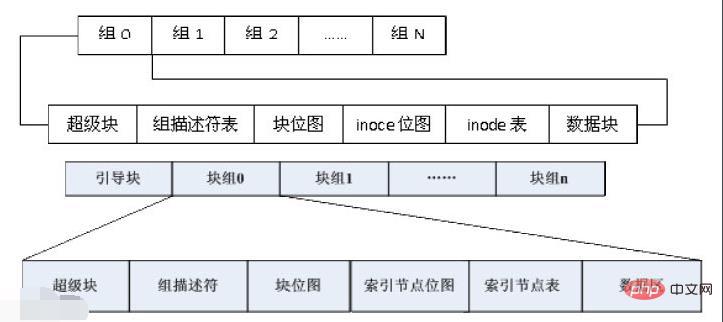 Operation and Maintenance
Operation and Maintenance
 Linux Operation and Maintenance
Linux Operation and Maintenance
 How to access devices in linux system
How to access devices in linux system
How to access devices in linux system
In the Linux system, devices are accessed in the form of files, because everything in Linux is a file, and a device corresponds to a device file. Accessing a device file is equivalent to accessing the device; in Linux, ordinary files and directory files Stored on disks or tapes called block physical devices.

#The operating environment of this tutorial: linux5.9.8 system, Dell G3 computer.
How to access the device in Linux system?
In the Linux system, access the device as a file. In Linux, everything is a file, and a device corresponds to a device file. Accessing a device file is equivalent to accessing the device.
In Linux, ordinary files and directory files are stored on disks or tapes called block physical devices. A Linux system supports several physical disks, and each physical disk can define one or more file systems. (analogous to computer disk partition). Each file system is composed of a sequence of logical blocks. A logical disk space is generally divided into several parts with different uses, namely boot block, super block, inode area, data area, etc.
Boot block: at the beginning of the file system, usually a sector, which stores the boot program and is used to read and start the operating system; super block: used to record the management information of the file system. A specific file system defines a specific super block; inode area (index node): a file or directory occupies an index node. The first index node is the root node of the file system. Using the root node, you can hang a file system on a non-leaf node of another file system; data area: used to store file data or management data.
The earliest file system type introduced by Linux is MINIX. The MINIX file system is defined by the MINIX operating system and has certain limitations. For example, the maximum length of a file name is 14 characters and the maximum length of a file is 64M bytes. The first file system designed specifically for Linux was EXT (Extended File System), but the most popular one currently is EXT4.
The second-generation extended file system was designed by Rey Card. Its goal is to provide a powerful extensible file system for Linux. It is also the most successfully designed file system in the Linux world. The super block of EXT2 can be accessed through the super block of VFS (struct ext2_sb_info ext2_sb), and the inode of EXT2 can be accessed through the inode of VFS (struct ext2_inode_info ext2_i).
The source code of the file system EXT2 is in the /usr/src/linux/fs/ext2 directory, and its data structure is in the file /usr/src/linux/include/linux/ext2_fs.h and in the same directory. defined in the files ext2_fs_i.h and ext2_fs_sb.h.
EXT2 file system divides the logical partition it occupies into block groups, as shown in Figure 1:

Recommended study: " Linux video tutorial》
The above is the detailed content of How to access devices in linux system. For more information, please follow other related articles on the PHP Chinese website!

Hot AI Tools

Undresser.AI Undress
AI-powered app for creating realistic nude photos

AI Clothes Remover
Online AI tool for removing clothes from photos.

Undress AI Tool
Undress images for free

Clothoff.io
AI clothes remover

Video Face Swap
Swap faces in any video effortlessly with our completely free AI face swap tool!

Hot Article

Hot Tools

Notepad++7.3.1
Easy-to-use and free code editor

SublimeText3 Chinese version
Chinese version, very easy to use

Zend Studio 13.0.1
Powerful PHP integrated development environment

Dreamweaver CS6
Visual web development tools

SublimeText3 Mac version
God-level code editing software (SublimeText3)

Hot Topics
 1667
1667
 14
14
 1426
1426
 52
52
 1328
1328
 25
25
 1273
1273
 29
29
 1255
1255
 24
24
 Linux Architecture: Unveiling the 5 Basic Components
Apr 20, 2025 am 12:04 AM
Linux Architecture: Unveiling the 5 Basic Components
Apr 20, 2025 am 12:04 AM
The five basic components of the Linux system are: 1. Kernel, 2. System library, 3. System utilities, 4. Graphical user interface, 5. Applications. The kernel manages hardware resources, the system library provides precompiled functions, system utilities are used for system management, the GUI provides visual interaction, and applications use these components to implement functions.
 vscode Previous Next Shortcut Key
Apr 15, 2025 pm 10:51 PM
vscode Previous Next Shortcut Key
Apr 15, 2025 pm 10:51 PM
VS Code One-step/Next step shortcut key usage: One-step (backward): Windows/Linux: Ctrl ←; macOS: Cmd ←Next step (forward): Windows/Linux: Ctrl →; macOS: Cmd →
 How to check the warehouse address of git
Apr 17, 2025 pm 01:54 PM
How to check the warehouse address of git
Apr 17, 2025 pm 01:54 PM
To view the Git repository address, perform the following steps: 1. Open the command line and navigate to the repository directory; 2. Run the "git remote -v" command; 3. View the repository name in the output and its corresponding address.
 How to run java code in notepad
Apr 16, 2025 pm 07:39 PM
How to run java code in notepad
Apr 16, 2025 pm 07:39 PM
Although Notepad cannot run Java code directly, it can be achieved by using other tools: using the command line compiler (javac) to generate a bytecode file (filename.class). Use the Java interpreter (java) to interpret bytecode, execute the code, and output the result.
 How to run sublime after writing the code
Apr 16, 2025 am 08:51 AM
How to run sublime after writing the code
Apr 16, 2025 am 08:51 AM
There are six ways to run code in Sublime: through hotkeys, menus, build systems, command lines, set default build systems, and custom build commands, and run individual files/projects by right-clicking on projects/files. The build system availability depends on the installation of Sublime Text.
 What is the main purpose of Linux?
Apr 16, 2025 am 12:19 AM
What is the main purpose of Linux?
Apr 16, 2025 am 12:19 AM
The main uses of Linux include: 1. Server operating system, 2. Embedded system, 3. Desktop operating system, 4. Development and testing environment. Linux excels in these areas, providing stability, security and efficient development tools.
 laravel installation code
Apr 18, 2025 pm 12:30 PM
laravel installation code
Apr 18, 2025 pm 12:30 PM
To install Laravel, follow these steps in sequence: Install Composer (for macOS/Linux and Windows) Install Laravel Installer Create a new project Start Service Access Application (URL: http://127.0.0.1:8000) Set up the database connection (if required)
 git software installation
Apr 17, 2025 am 11:57 AM
git software installation
Apr 17, 2025 am 11:57 AM
Installing Git software includes the following steps: Download the installation package and run the installation package to verify the installation configuration Git installation Git Bash (Windows only)



